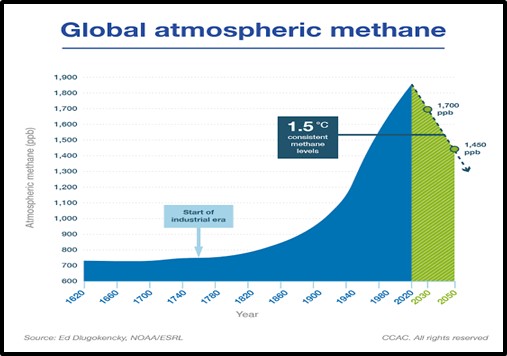SIMPLE VALVE COULD SLASH METHANE EMISSIONS
SIMPLE VALVE COULD SLASH METHANE EMISSIONS
Syllabus:
GS-3:
- Environment and environmental degradation
- Greenhouse gas and Climate Change
Why in the News?
A simple electric valve actuator could cut methane leaks—one of the most potent greenhouse gases. Despite technological availability and proven efficacy, market dynamics and weak enforcement stall its adoption. As the Global Methane Pledge falters, this editorial highlights a broader climate challenge—cost-cutting inertia prevailing over environmentally sound, economically viable solutions.
METHANE LEAKS FROM GAS ACTUATORS
- Major source: Gas-powered actuators leak methane in small amounts, which collectively contribute to over 50% of methane emissions in oil and gas sectors.
- Massive scale: The S. alone has 6 million of these controllers, with each potentially releasing 260 million cubic feet of methane annually.
- Emission impact: Methane is 72 times more potent than CO₂, making these leaks equivalent to burning 33 barrels of oil per actuator per year.
- Pervasive ignorance: Despite their importance, public and policy awareness around these devices remains low, limiting urgent regulatory and fiscal action.
- Unrealized potential: This simple valve represents a low-hanging climate solution that remains neglected despite clear benefits and manageable cost structures.
ELECTRIC ACTUATORS: A SOLUTION
- No leakage: Electric actuators, when powered by solar panels, eliminate routine venting, preventing continuous methane release into the atmosphere.
- Data integration: These devices provide real-time analytics, offering better pipeline control and maintenance alerts, enhancing efficiency and reliability.
- Quick payback: Though priced at $3,500, cost recovery occurs within years through gas savings and reduced maintenance expenses.
- Renewable synergy: Coupling electric actuators with solar power makes deployment feasible even in remote, off-grid locations.
-
Market sluggishness: Despite their clear edge, manufacturers like Rotork struggle due to poor demand and slow policy transitions.
GAS MARKET ECONOMICS STALL UPTAKE
- Price collapse: Natural gas prices are now a third lower, disincentivizing infrastructure upgrades that would be viable at higher energy prices.
- Slow growth: Global gas demand is projected to grow only 5% by 2030, weakening investor interest in new efficiency technologies.
- Profit illusion: Although leaks waste sellable gas, industry hasn’t acted—indicating low financial motivation for replacing leaking equipment.
- EPA limitations: Even after mandates on new installations, only 40% compliance is projected by 2030, indicating weak enforcement mechanisms.
- Market logic flaw: If cost savings alone were enough, the market would’ve adopted electric valves already, exposing the myth of market-driven climate change.
FAILURE OF METHANE PLEDGE GOALS
- Zero progress: Nearly four years post-Glasgow, no major cuts have occurred in methane emissions from the fossil-fuel industry.
- Voluntary limits: The Global Methane Pledge, a non-binding commitment, failed to translate into serious investment or accountability.
- Policy inertia: Advanced economies like the U.S. have not pushed comprehensive retrofitting mandates, despite technological readiness.
- Global inaction: Expecting nations like Russia or Iran to act without strong global enforcement is unrealistic and naive.
- Symbolic efforts: Most methane mitigation continues to be aspirational, disconnected from the operational priorities of major energy corporations.
FOSSIL INDUSTRY’S SELF-SABOTAGE
- Putin’s fallout: Russia’s 2022 invasion backfired by encouraging a global shift from pipeline gas to more secure but costly LNG.
- Demand disruption: Due to geopolitical instability, projected gas demand for 2030 has been revised down by 250 million tonnes.
- Climate dividend: Ironically, fossil fuel instability led to climate gains, as demand shrank without requiring major policy interventions.
- IEA findings: The International Energy Agency now estimates 735 million tonnes less gas usage by 2050—comparable to policy-driven reductions.
- Backdoor solution: Rather than policy, it’s fossil fuel geopolitics and volatility that are causing real emission reductions.
MISPLACED FAITH IN VOLUNTARISM
- Glasgow’s gap: Climate diplomacy overestimated industry self-interest, wrongly assuming companies would act without binding obligations.
- Optimism misfires: Voluntary agreements like the Global Methane Pledge have not proven more effective than mandated environmental reforms.
- Financial logic fallacy: Belief in a purely economic rationale for emission reduction ignores the industry’s resistance to change without pressure.
- Regulatory lag: In democratic systems, climate rules often face long delays, giving emitters years of leeway before compliance.
- Market ideology: The belief that free markets can solve complex global problems like climate change stands increasingly discredited.
NEED FOR SYSTEMIC INTERVENTIONS
- Public funding: Governments must subsidize replacements for high-leakage devices, especially in developing countries with growing fossil footprints.
- Global mandates: Only a UN-led compliance mechanism, not pledges, can ensure emission control standards across geopolitical divides.
- Climate penalties: Imposing carbon tariffs on countries or firms failing methane targets could incentivize timely change.
- Private partnerships: Climate-finance programs can help oil and gas firms share upgrade costs, especially in low-margin operations.
- Global awareness: Raising the profile of such low-tech, high-impact fixes could build citizen pressure on reluctant regulators and industries.
CONCLUSION
Electric valve actuators offer a simple, scalable solution to methane emissions but remain underused due to misplaced market faith, weak regulations, and falling gas prices. Voluntary pledges lack teeth; only binding, systemic interventions can drive adoption. Climate mitigation now hinges less on innovation and more on political will and global enforcement.
UPSC MAINS PRACTICE QUESTION
Discuss the significance of methane mitigation in global climate policy. Why has the Global Methane Pledge underperformed, and what systemic interventions are needed to achieve its goals?




